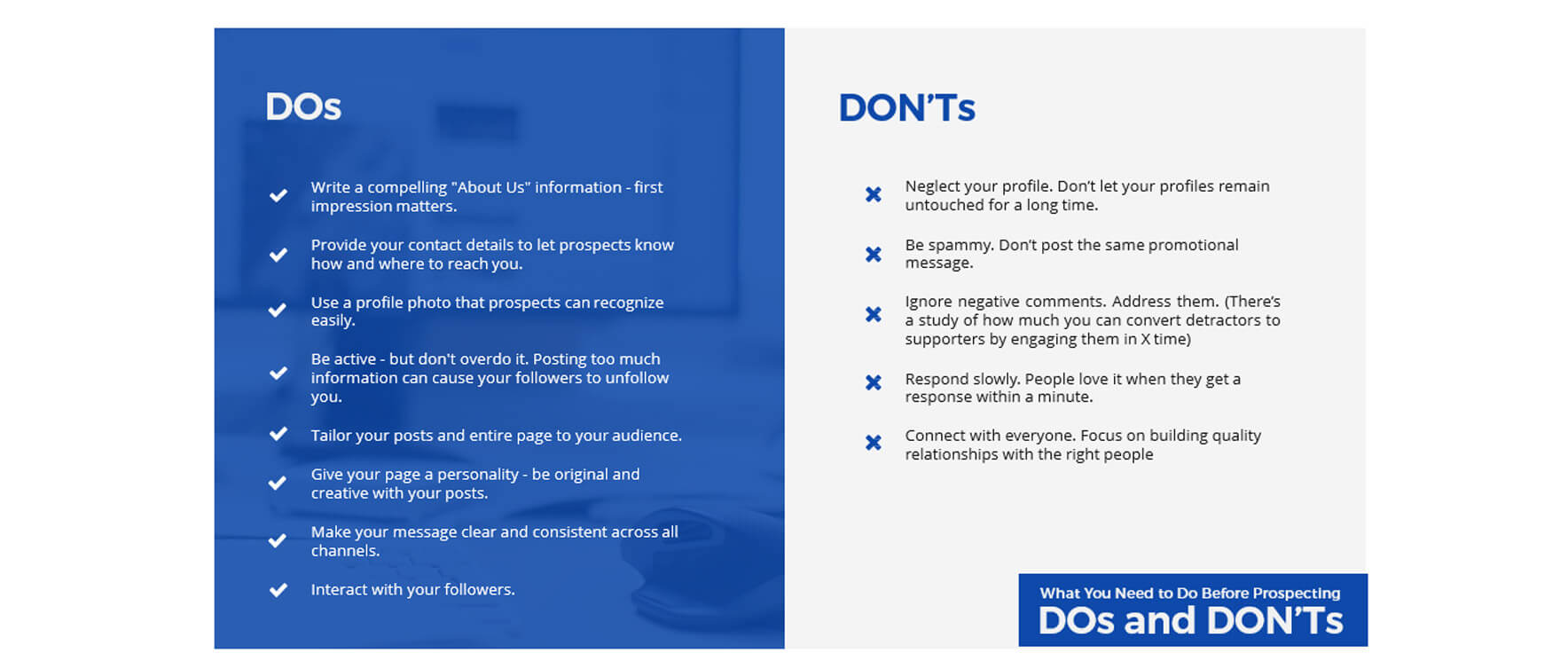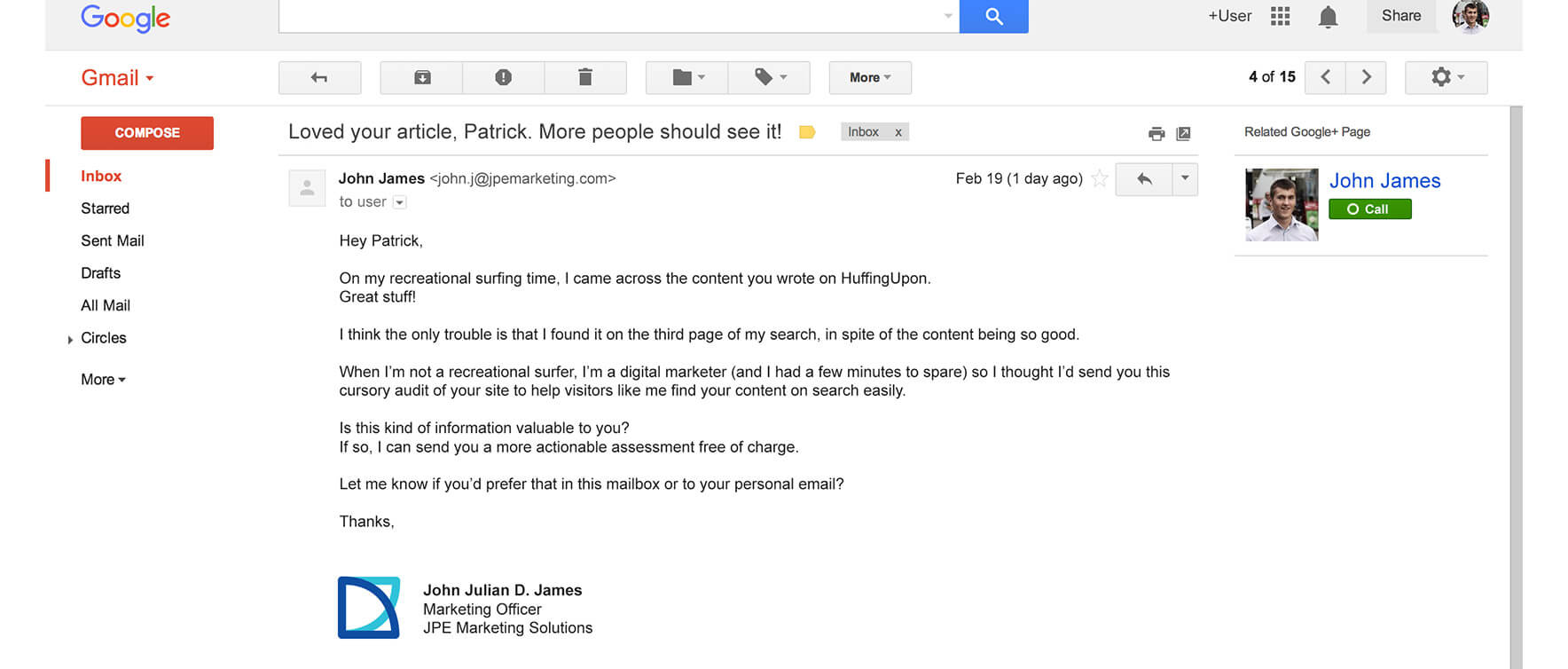We tackle the fundamentals of prospecting – everything from defining your target market to nurturing them once they become qualified leads.
But first, what is prospecting?
Sales Prospecting is the process of identifying potential customers that are likely to want or need your service, connecting with prospects, and laying the foundation for a conversation. This allows you to have a better understanding of who to reach out to when you’re diving into lead generation tools.
Sales prospecting for SEO clients is a process that starts with exhaustive research and requires every subsequent step to be equally exhaustive. This is because to be able to provide value at each step depends on the success of the step before it.
Fundamentals 1 and 2 are both parts of Step 0 – Preparation, which is the process of preparing your agency to be successful by building your identity. Here are some tips for preparing your social media accounts to catch your prospects attention:

Doing Market Research
Market research can feel like something “only the big agencies do.” The reality is that every SEO or digital marketing agency should do market research when choosing a niche to target and when prospecting.
If done properly, the market research you perform when choosing a niche can also be prospecting. Besides qualified sales leads, what results are you looking for in your market research? Here are the things we think you should pay extra attention to:
- Industry size – Are your potential SEO clients fighting a national battle or is the competition local only. As you can imagine, ranking your clients nationally is much more difficult than ranking them locally.
- ATV vs CLV – Do your potential SEO clients rely on average transaction value or customer lifetime value? It can be easier to justify a large marketing budget when the average transaction value is high, rather than low transaction values that add up over the customer lifetime. We’ll discuss this further in the next section.
- Networking opportunities & existing connections – Does your target market have plenty of networking opportunities? Do you see yourself networking with the people in the niche? Finally, do you have any existing connections in the niche that can give you a foot in the door?
- Your Competition – Are there existing SEO agencies in your target market that focus on the niche you are researching? A simple Google search can answer this question. Search for “niche + SEO + location.” Look for digital marketing agencies on the first page. If there are none, it’s an opportunity. If there are agencies on the first page, check out their website, and look for weaknesses.
In addition to identifying a niche and discovering sales leads, the result of your research should also help you develop a profile of your prospect and help you speak their language.
Targeting the Right Vertical
Once you have identified a niche with your market research. You want to have a primary vertical within the niche. It’s possible to focus on more than one vertical because by now you have an understanding of how they think but choosing a vertical can further help you laser focus your marketing efforts and later, your pitches.
Avoid low-profit margin, low volume verticals when starting out. These are businesses that don’t make much money on an individual sale and there either isn’t a need for customer loyalty or high customer lifetime value.
We recommend identifying a vertical with one of three prospecting activities:

Vertical Prospect Plan A
Verticals in Prospect Plan A have a high singular ticket value and typically a high-profit margin. They can be easier to sell to because a single ticket either covers the cost of your marketing or a significant portion. Examples are realtors and car dealerships.
Vertical Prospect Plan B
Verticals with a long customer lifetime value are the target of Prospect Plan B. These are businesses that either benefit from recurring revenue from the same person, as is the case with gyms or insurance companies, or have a high customer loyalty. Using the example of the insurance company, typically, all members of a family will use the same insurance company.
Vertical Prospect Plan C
Finally, for Vertical Prospect Plan C, determine which vertical creates extended networking opportunities. It can be hard to scale when referrals are your primary source of new clientele but when your SEO agency is still new, client referrals will be your bread and butter. Also, it never hurts to keep the referral sales pipelines warm just in case you have a lull in your lead generation.
Building Your Network
Now that you have identified your niche and vertical, you have learned the pain points of your prospecting leads, and how you can provide value, it’s time to build your network. For some agencies, this is the most difficult part because the best way to network is in person. But getting clients requires you to put yourself “out there”.
Start by finding out where business owners in your niche are likely to converge. This can sound like a lot of work but there are resources that make it easier. Great examples are Facebook and Eventbrite – these websites can help you find events, trade shows, or expos in your area.
Oftentimes you have to reserve a spot at these events. Do so early, add it to your calendar and actually go when the day arrives rather than find an excuse not to go. A benefit to registering early is that you may be able to establish networking opportunities with business leads before the event. This is especially true if you find the event on Facebook.
Provide value at the event. The best way to do this is with your website audit widget tool (find it in your white label dashboard!). It’s embedded on your agency’s website and allows you to easily submit SEO audits. Offer to perform an SEO audit of their website or a competitor’s website – providing instant value! Afterwards be ready with your business card.
If you simply cannot go to events there are less-effective alternatives like buying email lists or building your client database with tools like Haystack or Buzztack.
Contacting Your Prospects
Remember that in prospecting sales, you are the suitor. This means it is your responsibility to connect with your prospects and nurture the relationship. Ultimately, you want to be there when your prospecting leads are ready to become customers.
Understand that success can require several touchpoints or any way that a potential customer interacts with your agency. A key prospecting tip is to grade your prospects with a scoring sheet so you know whether you are winning or losing at prospecting. Prospect scoring also helps prioritize the prospecting leads that are ready to buy.
There are many ways to contact your prospects including cold emails and warm emails. There are also right and wrong ways to do each. Cold calls are an option but not recommend. Check out The ABCs of Prospecting Webinar for more prospecting techniques for digital marketing agencies.
Here is a great example of a warm email done right (note the personalized subject line):

It’s a good idea to invest in an email distribution platform – like MailChimp. You can also send out emails with the CRM in your white label dashboard – more robust features are on the way.
We strongly advise against using Gmail as it can detect if you are sending out the same email to several people and possibly tag it as spam – which could affect which folder your email winds up in. An additional benefit to using an email distribution platform or CRM is that it provides analytical data for the performance of your prospecting activity.
What do you do when you have a response? If you’re signed up for free access to your white label dashboard, contact your PM for a pre-intake assessment. Definitely reply immediately to your prospect with a timeline and offer a choice of 2 dates for an appointment.
Adapt and Improve
You will never stop prospecting for SEO leads unless you want to stop growing. However, you may adjust your process or emphasize a different prospecting technique as you evaluate the success of your prospecting activity.
An example of a possible adjustment could be a shift to focusing on social media. As a new agency, you’re unlikely to have a large social media following. But after building your client referrals and sales pipelines, sharing valuable content and becoming a better-known player in your market will become easier. LinkedIn will prove particularly useful. Your audience can serve as a source of sales leads.
Evaluate your cold emails and warm emails success in terms of open rates and response rates as mentioned earlier.
Evaluate your overall prospecting success by measuring your warming time and close rates. There are many things to consider here and we’ll save that for a later blog post.
- Open rates – The rate of opened emails.
- Response rates – The rate of responses – or leads captured – as a result of the campaign.
- Warming time – The amount of time between first contact and when a lead becomes a customer. Includes the various touchpoints.
- Close rates – The rate of leads closed – with closed being the conversion from a lead to a customer.
Why are these metrics important? Because these are the metrics that are the easiest to influence with a tweak to your messaging, upgrade of your sales process, or effective sales training. The sooner you find this out, the better.
Nurturing Your Leads

We’ve said this before and it’s worth reiterating – the goal is to be there when your prospects are ready to buy. Here are four ways to nurture your prospect leads:
- Personalized emails – Notice how we didn’t say “emails.” We said, “personalized emails” – emails that speak to exactly where your sales prospect is in the sales funnel. This can be accomplished through really precise segmenting or actually writing a personalized email. Always use their first name.
- Targeted content – Using targeted content as a way to nurture your sales leads will always be a marketing strategy to generate leads. It should always speak to your audience, always have a CTA that gets them to the next step and always be great content.
- Multichannel nurturing – We’ve already touched on using social media for sales prospecting and nurturing your leads. Other channels include paid advertisements, using dynamic web pages, and actual conversations.
- Touchpoints – This is more of an overall approach than an actual way to nurture. Remember that it usually requires multiple touchpoints including the three methods listed above.
Remember what you learned in your market research about target market- or niche-related pain points and the specific pain points of your SEO clients as individual businesses. Figure out how you can provide value and communicate that in the most compelling way possible.